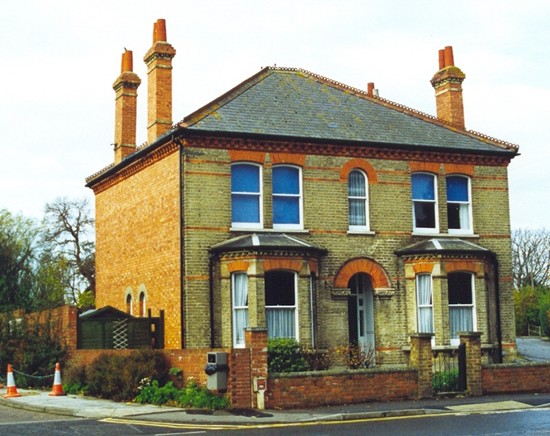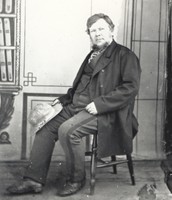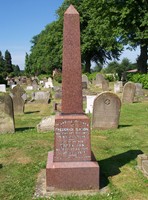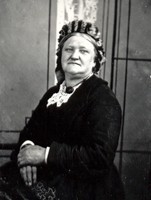|
Frederick Hinson
1837-1910

Rutland House pictured in November 1999
One of the grandest tombstones in
the town cemetery is a red marble obelisk that stands over the grave of
Frederick Hinson, a master builder, who spent most of his working life in
London and is remembered in Bourne for Rutland House which he built in
North Road on his return.
Frederick was born at Ketton, Rutland, and baptised there on 15th January
1837. He was the son of John Hinson of Bourne whose family were leading
members of the Methodist Church in the town, and a Ketton girl, Harriett
Chapell. John died on 8th February 1837, aged 24, when Harriett and her
young son went to live with her mother, Elizabeth, who had married William
Turner, in Bull Lane at Ketton, where she later became the schoolmistress.
By 1851, Frederick had left home and joined his uncle, Thomas Hinson, a
stonemason and builder, who lived at the Austerby at Bourne, and soon
learned the trade. He also became a member of the Congregational Church,
now the United Reformed Church, rather than continue with the family
tradition of Methodism, perhaps because the church was in Eastgate and
therefore a more convenient place for worship.
He married Sarah Ann Augood, daughter of James and Maria Augood who ran a
grocer’s shop in Eastgate, and they had two daughters. But he decided that
prospects in the trade were better in London than in Bourne and in 1860 he
and his family were living at Kentish Town where their son, also
Frederick, was born in 1865. They had several homes, usually moving with
his work of house building, but retained their religious connections by
worshipping at the Leighton Road Mission where Frederick junior became
choirmaster and leader of the orchestra. But Frederick and his wife always
returned to Bourne at Christmas to stay with relatives and friends and to
attend the New Year meetings at the Congregational Church.
Forty years after he had left, Frederick returned to Bourne to live and
continue in business, and although both of his daughters had died, his son
Frederick remained to carry on the family bricklaying firm in Kentish
Town. He came back in 1910 and his first task was to find a permanent home
and so he built Rutland Cottage at No 1 North Road the following year.
Many of the materials had come from grand houses in London that he had
helped demolish and were used to embellish the property such as cut glass
door knobs and finger plates and exotic tiling but are no longer in situ.
The name and the date 1901 can be seen sculpted into the surround on the
front door and it was so named because he had been born in the county.
He also gave more time to the Congregational Church, becoming a member of
the choir, a deacon and church secretary, and founder member of the Bourne
Brotherhood.
Frederick died at his home on Thursday 15th September 1910, aged 74. He
had been ill for six months and bedridden for the last two weeks of his
life. The funeral took place the following Tuesday with a service at the
Congregational Church where four workmen who had been employed by him
carried the oak coffin. A further service was held at the town cemetery as
the coffin was lowered into a brick vault which had been decorated with
flowers and sprays of evergreen. His widow, Sarah Ann Hinson, survived him
until 13th August 1917 when she died, aged 85, and was buried in the same
grave.
|
 |
 |
 |
|
Frederick Hinson and his wife Sarah pictured
with the grand red marble obelisk that marks their last resting
place in the town cemetery. |
After his death, Rutland Cottage changed hands several times and was the
home of Frederick Sones who lived there with his family from 1914 until he
died in 1934. There was a large orchard behind the house which also
belonged to Frederick Hinson and fruit from it was regularly sent to
friends and family in Kentish Town. When the Second World War ended in
1945, the property was leased to the government for use as the local
offices of the Department of Employment until sold in 1995 and is once
again a private house although considerably extended in recent years.
Descendents of Frederick Hinson survive, one of them the Rev David F
Hinson, his great grandson, who had moved to Stevenage, Hertfordshire. He
wrote to the Bourne Family History Society in February 1999: “Frederick’s
decision to move to London had a profound effect upon the history of my
family and I am glad that I was born and brought up in North London. I am
also glad that our links with Lincolnshire were not entirely broken
because I gladly acknowledge that my life’s work as a Methodist minister
owes not a little to the lively nature of that church’s witness in the
county during the last century and the passing on of the faith from
generation to generation.”
See also
Thomas Hinson
Frederick Sones

Go to:
Main Index Villages
Index
|



